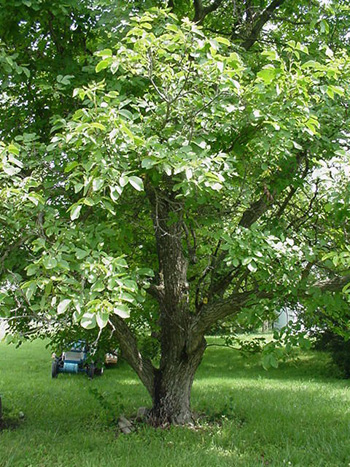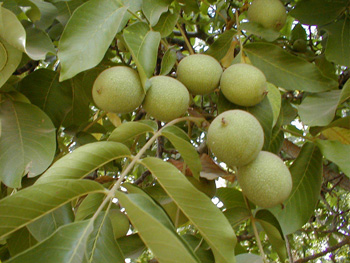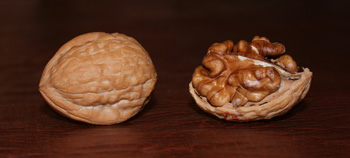Contents:
Common Names | Parts Usually Used | Plant(s) & Culture | Where Found | Medicinal Properties | Biochemical Information
Uses | Formulas or Dosages | Nutrient Content | Bibliography
Scientific Names

- Juglans regia L.
- Juglandaceae
- Walnut family
Common Names
- Walnut
- Caucasion walnut
- Circassian walnut
- Persian walnut
Parts Usually Used
Leaves, outer hulls and bark
Back to Top

Description of Plant(s) and Culture
The English walnut tree is widely cultivated for its wide-spreading branches. It grows to about 80 feet high and has gray bark and oblong-ovate, entire leaflets that are sticky when young but glabrous later. Blooming in May, the male flowers appear in axillary catkins, the female in terminal spikes. The fruit is the common walnut.
Back to Top
Where Found
Cultivated
Back to Top

Medicinal Properties
Astringent, tonic, nutritive, demulcent, laxative (bark), stomachic. Juglone is believed to have an antifungal property; the hulls and leaves are highly astringent and contain tannin as well as juglandin, a bitter principle.
Back to Top
Biochemical Information
Juglone, isojuglone, essential oil, inositol, phytin, phytosterols, oxidase, vitamins A, B, C, and E, and ellagic, laric, myristic, arachic, linoleic, linolenic, isolinolenic, and oleic acids
Back to Top
Uses
Leaf tea is a tonic to the stomach and promotes good appetite; used for catarrhal enteritis. The decoction used externally as a wash or bath additive for rheumatism, gout, glandular swelling, gum problems, scrofula, sweaty feet, acne, dandruff, skin problems, and excessive milk flow after the child has been weaned. A decoction of the green shell surrounding the walnut has been recommended for failing virility. Use the infusion as a rinse for hair loss.
Back to Top
Formulas or Dosages
Decoction: use 4 tsp. leaves or chopped green shells with 1 cup water. Take 1 cup a day, a mouthful at a time.
Bath Additive: boil 1 lb. dried leaves in 1 1/2 qt. water for 45 minutes, and add the liquid to the bath water. For a footbath, reduce the amounts proportionately.
Back to Top
Nutrient Content
Vitamins A, B, C, and E.
Back to Top
Resource Links
Mayo Clinic – Cholesterol: Top 5 foods to lower your numbers
PubMed.gov: Antihypertriglyceridemic effect of walnut oil.
PubMed.gov: Blood cholesterol and walnut consumption: a cross-sectional survey in France.
Bibliography
![]() The Complete Medicinal Herbal
The Complete Medicinal Herbal, by Penelope Ody, Dorling Kindersley, Inc, 232 Madison Avenue, New York, NY 10016, First American Edition, copyright 1993
![]() The Herb Book
The Herb Book, by John Lust, Bantam Books, 666 Fifth Avenue, New York, NY. copyright 1974.
![]() The Nature Doctor: A Manual of Traditional and Complementary Medicine
The Nature Doctor: A Manual of Traditional and Complementary Medicine, by Dr. H.C.A. Vogel; Keats Publishing, Inc., 27 Pine Street (Box 876) New Canaan, CT. 06840-0876. Copyright Verlag A. Vogel, Teufen (AR) Switzerland 1952, 1991
![]() Planetary Herbology
Planetary Herbology, by Michael Tierra, C.A., N.D., O.M.D., Lotus Press, PO Box 325, Twin Lakes. WI 53181., Copyright 1988, published 1992
![]() Webster’s New World Dictionary
Webster’s New World Dictionary, Third College Edition, Victoria Neufeldt, Editor in Chief, New World Dictionaries: A Division of Simon & Schuster, Inc., 15 Columbus Circle, New York, NY 10023
